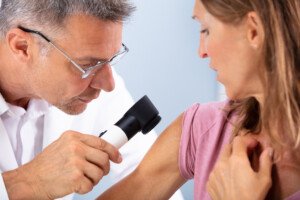Rather than worry that scratching a mole raises melanoma risk, you should be concerned that a mole that bleeds from the lightest scratch IS melanoma.
However, this is not likely since often, scratching can cause a little bleeding.
If you scratch your skin hard enough with a good solid nail, it may draw a little blood, and that’s normal.
A mole is a part of your skin. So if a mole just happens to be in the path of your nails, it may bleed as well.
The itch may not even be the mole itself, but the mole is close enough to the scratching that it gets micro-traumatized.
What’s more worrisome is if the healing from the bleeding is taking a long time.
“Any mole can start to bleed if sufficiently traumatized, for example through scratching or being located under a garment strap,” says Estee Williams, MD, a board certified medical, cosmetic and surgical dermatologist and assistant clinical professor in dermatology at Mount Sinai Medical Center.
“However, any mole that bleeds spontaneously — with no good explanation — should be evaluated by a dermatologist in person.”
It’s also a whole new ball game when the spot that itches IS the mole. Even if it doesn’t bleed, an itching mole needs to be examined by a dermatologist.
Not all itching moles turn out to be melanoma, but melanoma can definitely cause a mole to itch.
Rather than keep wondering what could be making the mole itch, make an appointment with a dermatologist.
“Often, the overlying blood-crust makes the examination a bit more difficult, so unless it looks very suspicious, I usually recommend allowing it to heal over two weeks and then rechecking,” says Dr. Williams.
“Patients appreciate this plan because I’m not rushing to test every single bleeding mole.”
And by the way, scratching a benign mole will not turn it into melanoma, and if it’s already cancerous, any scratching will not spread the malignancy or make the cancer grow faster.
Cancer begins at the DNA level, not at the macro level of scratching the skin.
Dr. Williams’ clinic provides a state-of-the-art technology called serial digital dermoscopy.
With SDD, all of the patient’s moles are “mapped” photographically and then fed into a computer database where they are assigned a rating ranging from benign to highly suspicious for melanoma.
Every year the same moles are photographed. The computer can make comparisons to previous images and detect changes.
This technology is ideal for those at high risk for melanoma or who have difficult-to-inspect moles on their back.

Dr. Williams strives to be at the forefront of her field, being active in local, national and international medical and cosmetic dermatology conferences.
 Lorra Garrick has been covering medical, fitness and cybersecurity topics for many years, having written thousands of articles for print magazines and websites, including as a ghostwriter. She’s also a former ACE-certified personal trainer.
Lorra Garrick has been covering medical, fitness and cybersecurity topics for many years, having written thousands of articles for print magazines and websites, including as a ghostwriter. She’s also a former ACE-certified personal trainer.
.









































